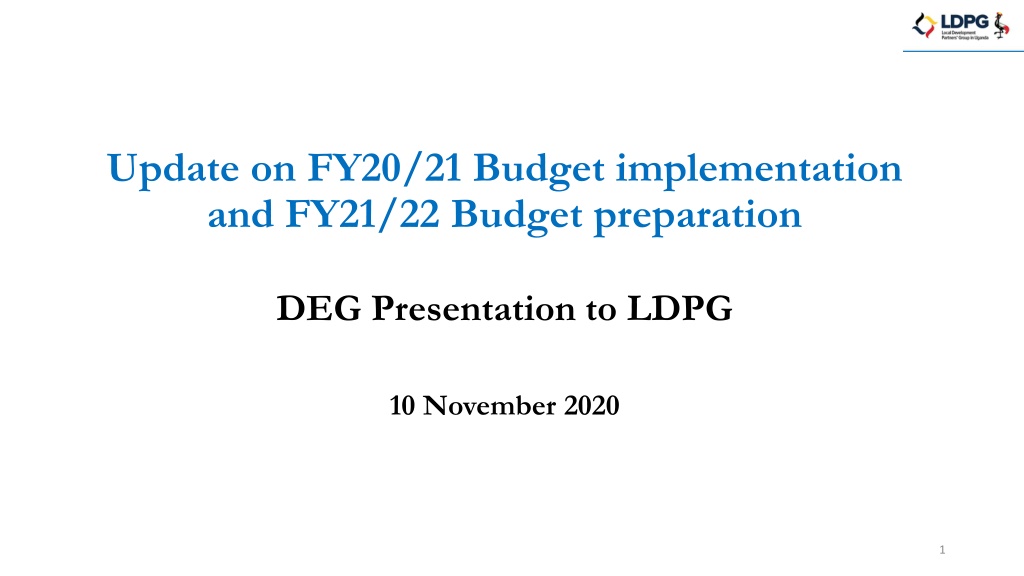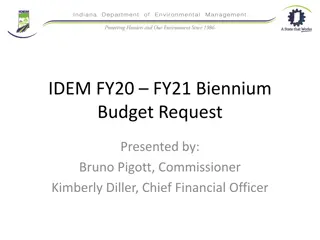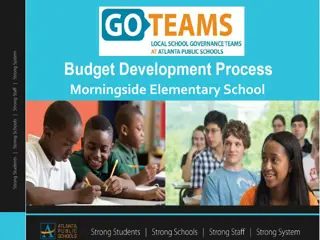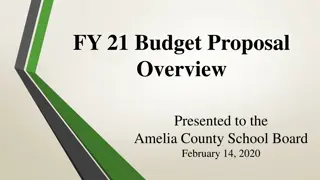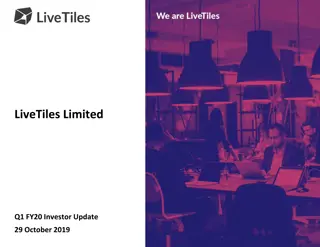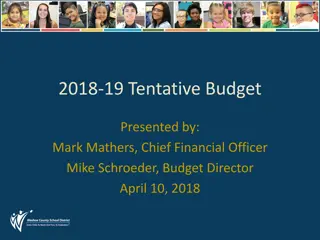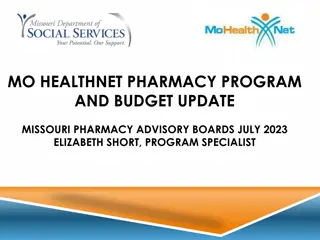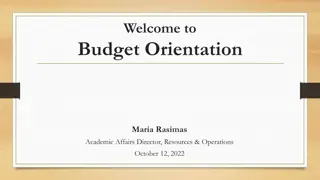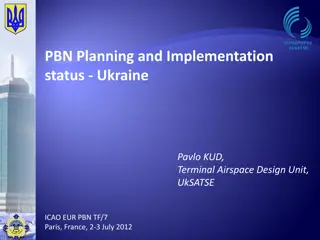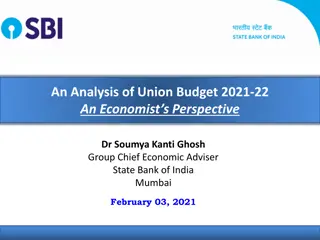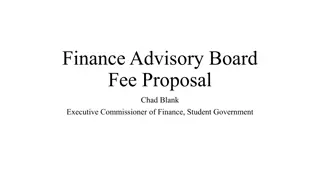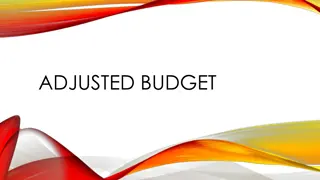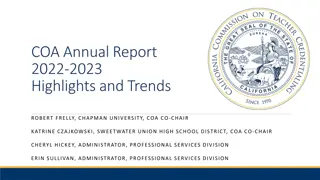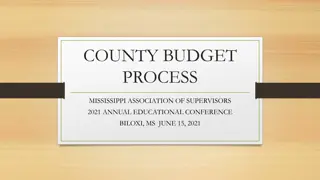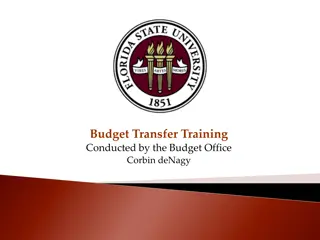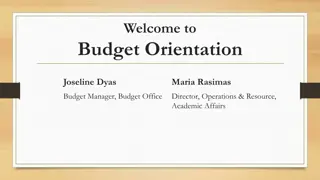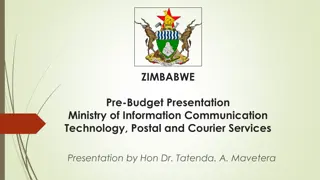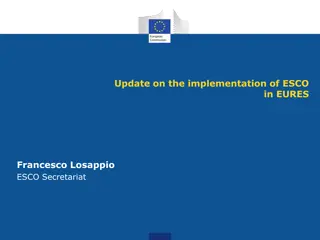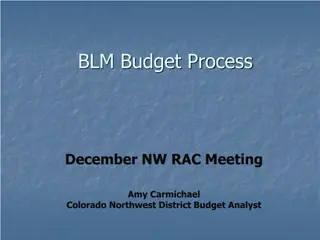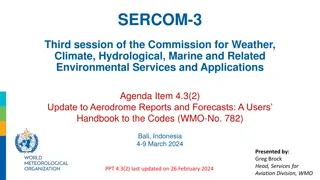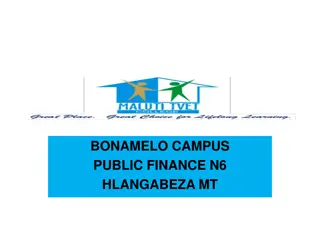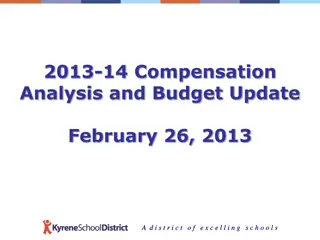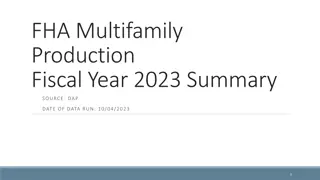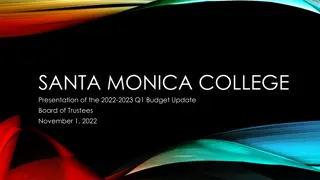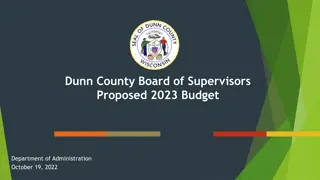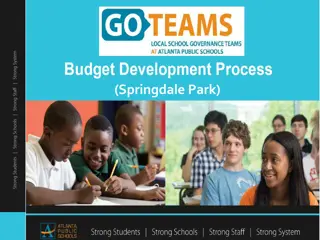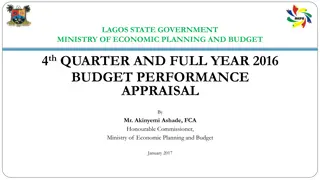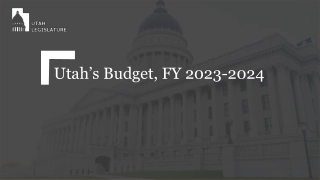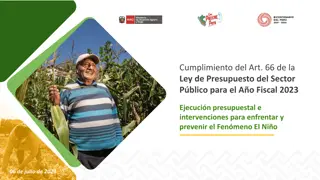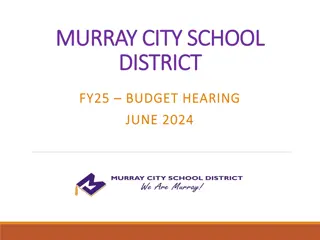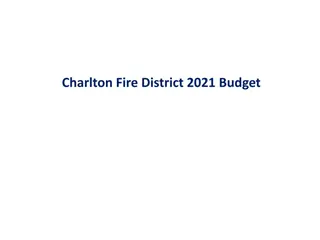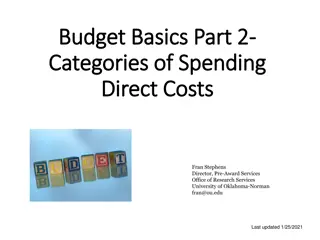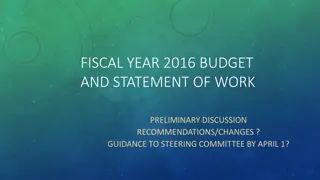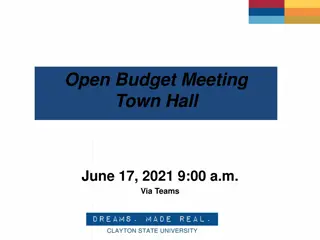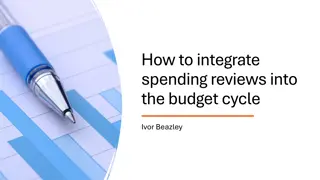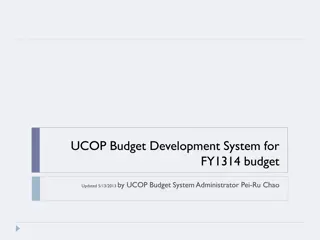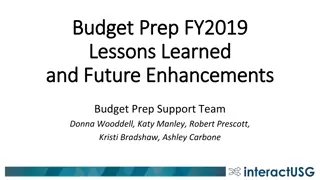Update on FY20/21 Budget Implementation & FY21/22 Budget Preparation DEG Presentation to LDPG
This presentation provides an update on the approved FY20/21 budget, its performance, reprioritization, supplementary budget requests, and an overview of the FY21/22 budget. It also highlights the shift to Program Based Budgeting and DP engagement, as well as key issues for the LDPG. The approved budget's financing sources, sectoral allocations, and the deteriorating fiscal position are discussed, along with the Q1 performance showing spending, revenue, and grants figures. The reprioritization approach outlined in a Cabinet Paper is also mentioned.
Download Presentation

Please find below an Image/Link to download the presentation.
The content on the website is provided AS IS for your information and personal use only. It may not be sold, licensed, or shared on other websites without obtaining consent from the author. Download presentation by click this link. If you encounter any issues during the download, it is possible that the publisher has removed the file from their server.
E N D
Presentation Transcript
Update on FY20/21 Budget implementation and FY21/22 Budget preparation DEG Presentation to LDPG 10 November 2020 1
Outline of the Presentation a) Approved FY20/21 Budget b) FY20/21 Budget performance c) FY20/21 Budget reprioritization d) FY20/21 Supplementary Budget requests e) Overview of FY21/22 Budget f) Shift to Programme Based Budgeting and DP engagement g) Next steps and key issues for LDPG 2
Approved FY20/21 Budget Financing Sources 42,000 36,000 12,422 30,000 Total Approved Budgets 10,109 Ushs Billion 50,000 24,000 45,494 18,000 40,488 40,000 25,586 12,000 23,927 32,703 6,000 29,008 UShs Billion 30,000 0 2019/20 2020/21 20,000 Domestic External 10,000 Domestic Sources 25,000 - 20,000 FY17/18 FY18/19 FY19/20 FY20/21 2019/20 2020/21 UShs Billion 15,000 10,000 5,000 0 URA NTR Petroleum Fund Domestic Borrowing AIA & LR 3
Approved FY20/21 Budget sectoral allocations 20 2019/20 18 2020/21 16 14 12 Percentage 10 8 6 4 2 - 4
Deteriorating fiscal position 25% 20% 15% % GDP 10% 5% 0% FY11 FY12 FY13 FY14 FY15 FY16 FY17 FY18 FY19 FY20 FY21p Fiscal deficit Total expenditure (actual) Tax revenue 5
FY20/21 Budget performance Q1 Spending 2,000 Revenue and Grants 2,400 1,600 2,000 UShs Billion 1,200 1,600 UShs Billion 1,200 800 800 400 400 - - Approved Outturn Approved Outturn Approved Outturn Approved Outturn Approved Outturn Approved Outturn July August Sept July August Sept Revenues Grants Recurrent Development Domestic Arrears Source: MoFPED (2020), Performance of Economy reports Despite a deficit in Sept, taxes were 12% above the quarter target Grants were 67% below the quarter target Recurrent and development spending below (87% and 80% respectively) the quarter target Arrears payments were about 20% below the quarter target 6
FY20/21 Budget reprioritization approach Cabinet Paper on Budget reprioritization was approved expecting a summary of key decisions from MoFPED Director Budget confirmed that Cabinet Paper contained four key points: a. Identified UShs 1.4 trillion (e.g. travel) that has been frozen for other purposes any further cuts will depend on revenue gaps and/or ability to mobilize additional financing b. Expected revenue shortfall will be about UShs 2.5 trillion c. Additional stimulus package of UShs 1.7 trillion identified to address COVID impact some of this is in the Supplementary Budgets that have already been announced d. Additional borrowing that will be required already tabled a request to borrow up to UShs 6.2 trillion (UShs 4 trillion from domestic market and UShs 2.2 trillion from IMF) Budget adjustments will continue through forced suppression of spending for unprotectedvotes and/or supplementary budgets 7
Budget reprioritization according to 1st BCC FY21/22 Proposed budget cuts 3,500 9% Development Breakdown 8.1% 8% 3,000 7% GoU Projects , 348.03 , 17% Externally Financed Projects (GoU Component), 129.64 , 6% Share of Total Budget 2,500 6% UShs Billon 5.5% 2,000 5% 4% 1,500 Externally Financed Projects 1,595.55 , 77% 3% 1,000 2.6% 2% 500 1% 972.03 2,073.22 3,045.25 - 0% Recurrent Dev't Total Source: 1st Budget Call Circular FY 21/22 About UShs 3 trillion (8.1%) of the approved budget was identified for budget cuts About UShs 1.6 trillion are externally financed projects. Has there been a discussion with DPs on this? How was this decided? On-going or new projects? 8
FY20/21 Supplementary Budget requests Amount requested (billion) Date of Request Share of Schedule Source of Funding Approved Budget Borrowing from IMF and World Bank No.1 27 July 2020 1,363 3.0% No.2 1 Oct 2020 2,063 4.5% Additional borrowing (domestic market/IMF) Addendum to No.2 6 Oct 2020 389 0.9% Total 3,815 8.4% 9
FY20/21 Supplementary Budget approvals No.1 UShs 6.4 bn for payment of domestic arrears to tea seedling suppliers (under NAADS) to be deferred pending further information regarding verification of suppliers Requested MoFPED Approved Parliament Schedule Diff. No.1 1,363 1,357 6.4 No.2 Ministry of Energy & Mineral Dev t: UShs 50 bn deferred to allow more time to study the costs of deemed energy shortfalls in FY s 19/20 and 20/21 No.2 2,063 1,983 80.2 Addendum to No.2 389 389 0.0 No.2 Ministry of Justice & Constitutional Affairs: UShs 30.2 bn deferred pending verification of war claimants in Acholi, Lango and Teso regions and conclusion of the Presidential and Parliamentary elections Total 3,815 3,729 86.6 10
Supplementary Budget trends Total value and share of supplementary budgets 4,000 9% 8.2% 8% 8.0% 3,500 7% 3,000 6% UShs Billion 5.9% 2,500 5.0% 5% 2,000 3,729 4% 3.7% 3,249 3.6% 1,500 3% 1,000 2% 1,709 1,650 500 958 1% 889 - 0% 2015/16 2016/17 2017/18 2018/19 2019/20 2020/21* L: Amount R: Share of Approved Budget *Q1 and Q2 of FY20/21 11
FY20/21 Supplementary Budget beneficiaries % of original Budget 26% MDA Sch. 1 Sch. 2 Adden. Sch. 2 Total (billion) Share Min of Defence MoFPED State House Local Gov'ts Min of Works and Transport Domestic Arrears Ministry of Health Min of Trade, Industry & Coop s NAADS URA National Medical Stores Electoral Commission Others (12 MDAs) TOTAL O/w Covid-19 Related* 1,124.5 95.6 250.0 10.3 220.0 1,124.5 711.3 451.0 400.7 221.8 216.0 139.3 100.7 100.0 60.9 50.0 50.0 102.6 3,728.7 912.1 30.2% 19.1% 12.1% 10.7% 5.9% 5.8% 3.7% 2.7% 2.7% 1.6% 1.3% 1.3% 2.8% 100% 24.5% 615.2 201.0 6.8 1.8 216.0 89.3 100.0 0.5 390% 110% 383.6 10% 14% - 50.0 11% 0.7 114% 100.0 66% 60.9 14% 50.0 50.0 32.4 1,982.8 50.0 12% 9% 65.6 1,356.6 860.1 4.6 389.3 2.1 3.2% - - 12
FY20/21 Supplementary Budget beneficiaries ctd MDA Activities 455bn recapitalization of UDB; 50bn transfer to MFSC; 160bn for Emyooga; and 46bn to pay the outstanding loan obligation of UTL to Trade and Development Bank (TDB) 100bn transfer to UDC to partner with businesses that invest in priority import substitution and export-oriented projects; and procure a vehicle for Senior Presidential Advisor on Africa Growth Opportunity Act (AGOA) Classified expenditure and support dev't of anti-tick vaccine 100bn to meet the proposed interventions for the Presidential Initiative on Agro-lndustrialisation for Local Economic Development (AGRf-LED). Program is being piloted in Rwenzori sub- region and seeks to facilitate investment projects for Agro-Industrialization 1,125bn for classified development expenditure (technological advancements etc.). Procurement of face masks (33bn); Transport and allowance for distribution of face masks (2.3bn); Procurement of test kits and laboratory consumables (37bn); e-modelling of Intensive Care Units (7bn); Support to LGs for District-based Surveillance activities in the forty border districts and other districts with COVID-I9 cases (4bn); Tents (6bn) 358bn transfer of funds from former municipalities to the newly created cities; 24bn transfer from Arua district to the newly created Terego district; and 10bn for UGIFT for the completion of construction of seed secondary schools and completion of upgrade of HCIIs to IIIs. MoFPED Ministry of Trade, Industry & Cooperatives State House NAADS Ministry of Defence Ministry of Health Local Gov'ts 13
FY20/21 Supplementary Budget concerns a. b. c. d. Size of Supplementary Budgets after just two quarters of the FY Borrowing in the domestic market (could be larger if IMF financing does not materialise) 42% of total supplementary is classified expenditure for State House and MoD UShs 220 bn for 223km PPP road project in DRC. GoU & DRC Gov to finance 40% of the project cost and 60% from Dott Services. Concerns on how Dott Services was selected/procured to construct and finance the road. UShs 100 bn for interventions under the Presidential Initiative on Agro-Industrialisation for Local Economic Development (AGRf-LED) piloted in Rwenzori sub-region by NAADS and OWC. Increasing role of OWC! UShs 650 m for procurement of a vehicle for Senior Presidential Advisor on AGOA. This does not qualify for supplementary spending (i.e. unavoidable and unforeseeable), which points to bad budgeting. e. f. 14
Overview of Budget FY21/22 10,000 Preliminary Budget is UShs 40,715 Bn Drop in the Budget by 11% - narrowing the fiscal deficit Financing: domestic is UShs 21,073 Bn and external is UShs 5,475 Bn Yet, increase in Interest payments by 19% Drop in Agro- industrialisation; Integrated Transport Infrastructure & Services; and Human Capital Dev't by 19%, 12% and 7% respectively 9,347 Approved 2020/21 Projected 2021/22 9,000 8,000 6,847 7,000 6,463 6,017 5,875 6,000 UShs (Billion) 5,170 4,822 5,000 4,050 4,000 3,000 2,000 1,638 1,334 1,000 262 253 187 175 92 79 - Source: 1st Budget Call Circular FY 21/22 15
Shift to Programme Based Budgeting For FY21/22 starting to align Budgeting to planning in line with 18 NDPIII programmes Programmes replacing Sectors; each Programme to develop a PIAP; PWGs replaced SWGs However, several challenges have been identified: a. Complexities numerous stakeholders and consensus building within the PWGs especially on leadership, management and monitoring issues b. Change budget architecture and systems (change Chart of Accounts, reconfiguring of the PBS and IFMS) c. Inadequate capacity across MALGs to implement the reform d. Limited engagement by DPs e. Timelines are very tight: 3 Nov PIAPs expected from NPA (following quality assurance), 13 Nov BFPs to MoFPED, 30 Nov NBFP submitted to Parliament 16
FY 21/22 Budget preparation timeline (2020) Activity Submission of Budget Framework Papers to MoFPED Consultations with DPs on Budget Strategy for FY21/22 Top Management Meeting on Draft NBFP for FY21/22 Consolidated statement of Multiyear Expenditure Commitments and DC Appeals for FY21/22 Meeting with H.E. the President on NBFP for FY21/22 Submission of Cabinet Memo on NBFP FY 2020/19 Cabinet Meeting on the NBFP for FY 2021/2022 Submission of NBFP for FY 2021/2022 to Parliament Update on the Financing commitments from the DPs Proposed deadline 13 Nov 17Nov 1 2 18Nov 18Nov 3 4 19Nov 20Nov 23Nov 30Nov 24 Dec 5 6 7 8 9 17
FY21/22 Budget preparation DPG engagement DEG Engaging with Director Budget to understand FY20/21 Budget re-prioritization, progress on transition to PBB (i.e. preparation of PIAPs and BFPs) and entry points for DP engagements. Met with ED NPA to provide clarity on transition to PIAPs and PWGs. Met with CSOs and agreed on several actions including sharing information on Budget implementation and having more regular engagements. There has, however, been limited broader DP engagement in the FY21/22 Budget process Agro-Industrialisation: DPs were given a day to comment on the PIAP and provide support (undefined) Agri-DPG commented, but could have done better if given more time. Human Capital Development: Education DPs had a meeting with MoES in early October to understand how DPs could engage no progress since then. Health DPs have not engaged in development of PIAP, waiting for MoH guidance. Integrated Transport and Infrastructure Services: DPs not yet engaged in PIAP development. 18
Shift to Program Based Budgeting way forward Given that Chart of Accounts and IT Systems have not been configured, full implementation of PBB cannot be achieved in next year s Budget Thus, alignment of Budget to NDPIII to be done in a phased manner: a. Phase 1: FY21/22 (not fully alignment) PWGs (coordination centers) to prepare PIAPs out of the system These PIAPs, or Programme BFPs, will show the objectives and planned interventions in each programme However, each Vote will then submit their BFPs through the current system Phase 2: full implementation of the PBB will be effective in FY22/23 once Chart of Accounts and systems have been fully modified to conform with NDPIII programmes Restructuring of Government is required to facilitate smooth implementation of NDPIII b. 19
Shift to Program Based Budgeting DP support Continue to engage in the process through PWGs and developing the PIAPs although time is very limited, so not sure how this will play out Capacity building and enhancing human capacity (TA, training of government officials, experiences of other countries) an initial ToR has been shared with UNDP who have offered to provide support Adjusting and updating systems (e.g. PBB and IFMS) 20
DEG next steps a. Continue to follow-up with MoFPED, NPA, DPGs and PWGs (particularly 4 key programmes) b. Regular engagements with Director Budget - MoFPED c. Gather and share information with other stakeholders, especially CSOs involved in Budget related advocacy and monitoring d. Keep LDPG updated on progress and challenges 21
Key issues for LDPG attention and action 1st BCC budget cuts for FY20/21 About UShs 1.6 trillion are externally financed projects clarity from MoFPED on what drove these cuts and if concerned DPs were consulted? Supplementary budgets Engage MoFPED on diminishing Budget credibility, classified expenditures, alignment with NDPIII/national development priorities Ensure better DP alignment (i.e. planning and funding) to GoU Budget cycle Push for PFM reforms especially on Budget execution/implementation a. b. c. Budget for FY21/22 Significant drop in projected external financing (Ushs 12.4 to 5.5 trillion FY20/21 to FY21/22) Reduction in proposed FY21/22 allocations to Agro-industrialisation and Human capital dev't Alignment of programme budgets to NDP III, given some PIAPs are not in place AMP process? 22
Thanks! 23
